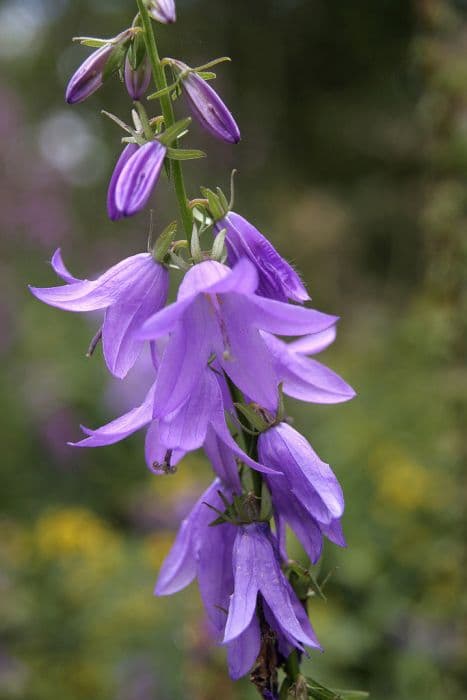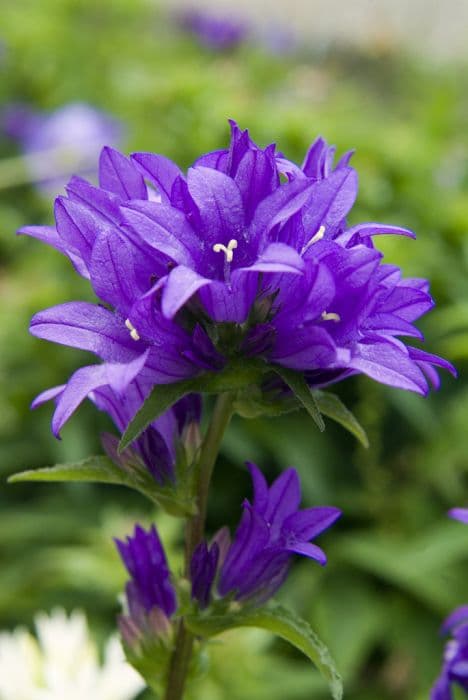Mexican Cardinal Flower Lobelia laxiflora

ABOUT
The Mexican Cardinal Flower, known commonly as Lobelia laxiflora, is a distinctive plant with a bushy and sprawling habit. Its leaves are narrow, elongated, and slightly serrated on the edges, exhibiting a green to occasionally reddish hue. The plant is well-known for its vibrant and tubular flowers, which typically display a radiant combination of red and yellow colors, drawing immediate attention with their fiery appearance. The flowers are arranged loosely along the stems, adding to the airy and open feel of the plant's structure. The blooms possess a unique flared shape, resembling miniature trumpets, which are particularly attractive to hummingbirds and butterflies. The Mexican Cardinal Flower exudes a wild and natural charm, often contributing an exotic touch to gardens where it is cultivated.
About this plant
 Names
NamesFamily
Campanulaceae
Synonyms
Mexican Cardinal Flower, Sierra Madre Lobelia, Loose-Flowered Lobelia
Common names
Lobelia laxiflora var. angustifolia, Tupa laxiflora.
 Toxicity
ToxicityTo humans
Lobelia laxiflora, commonly known as the Mexican Cardinal Flower, is not widely reported as a toxic plant to humans. However, other species in the Lobelia genus do contain alkaloids such as lobeline, which can be toxic in large amounts. As there is limited specific information about the toxicity of Lobelia laxiflora to humans, it is generally advisable to avoid ingesting any part of the plant. If ingested, it may potentially cause symptoms similar to those caused by other Lobelia species, which include nausea, vomiting, diarrhea, cough, dizziness, tremors, and difficulty breathing. In cases of suspected poisoning, medical attention should be sought.
To pets
Mexican Cardinal Flower is also not well-documented for its toxicity in pets. However, as with humans, other Lobelia species are known to contain compounds that can be harmful if consumed. Pets, particularly cats and dogs, should not ingest this plant. If they do, they might experience symptoms like vomiting, diarrhea, excessive salivation, lethargy, and possibly more severe reactions such as seizures. Owners should ensure their pets do not have access to this plant, and if ingestion is suspected, contact a veterinarian immediately.
 Characteristics
CharacteristicsLife cycle
Perennials
Foliage type
Semi-deciduous
Color of leaves
Green
Flower color
Red
Height
2-3 feet (0.6-0.9 meters)
Spread
2-3 feet (0.6-0.9 meters)
Plant type
Shrub
Hardiness zones
9
Native area
Mexico
Benefits
 General Benefits
General Benefits- Attracts Hummingbirds: Lobelia laxiflora is known for attracting hummingbirds due to its tubular red and yellow flowers which provide a natural food source for these birds.
- Easy to Grow: This plant is considered low maintenance and can thrive in a variety of soil conditions, making it a good choice for both novice and experienced gardeners.
- Drought Tolerant: Once established, Mexican cardinal flower is drought-tolerant, making it suitable for xeriscaping and reducing the need for frequent watering.
- Adds Color: With its vibrant flowers, it can add a splash of color to gardens, especially during its blooming season in the summer and fall.
- Supports Biodiversity: Provides nectar for a variety of pollinators, supporting local ecosystems and promoting biodiversity in the garden.
- Landscape Use: Ideal for use in borders, flower beds, and as a focal point in a garden due to its striking appearance.
- Deer Resistant: The plant is relatively resistant to deer, which can help to protect it and other surrounding plants in deer-prone areas.
 Medical Properties
Medical Properties- This plant is not used for medical purposes.
 Air-purifying Qualities
Air-purifying QualitiesThis plant is not specifically known for air purifying qualities.
 Other Uses
Other Uses- Lobelia laxiflora, commonly known as Mexican Cardinal Flower, can be used as an ornamental plant to attract hummingbirds and butterflies to gardens due to its bright red and yellow tubular flowers.
- The plant can be used as a natural pest deterrent in gardens; certain insects may avoid the area where it is planted.
- Mexican Cardinal Flower can be included in a xeriscape garden design, which is a landscaping approach that reduces or eliminates the need for supplemental water from irrigation.
- The stems and leaves of Lobelia laxiflora can be used to create natural dyes for fabrics, yielding subtle green or yellow hues.
- It can be used in education to teach students about pollination processes due to its attractiveness to pollinators like hummingbirds.
- This plant can be part of a habitat restoration project, especially in areas where it is native, to help maintain local biodiversity.
- Lobelia laxiflora can be used in a mixed flower border for succession planting as it blooms later in the season, providing color when earlier flowers have faded.
- The long stems of Mexican Cardinal Flower can be used in flower arrangements, giving height and a splash of color to ornamental displays.
- Its presence in the garden can be a bioindicator of ecological health, particularly in its native range, as it thrives in certain soil conditions.
- These plants can be used to create a natural privacy screen or living fence in a garden due to their bushy growth habit.
Interesting Facts
 Feng Shui
Feng ShuiThe Mexican Cardinal Flower is not used in Feng Shui practice.
 Zodiac Sign Compitability
Zodiac Sign CompitabilityThe Mexican Cardinal Flower is not used in astrology practice.
 Plant Symbolism
Plant Symbolism- Persistence: Lobelia laxiflora, commonly known as the Mexican Cardinal Flower, is a hardy plant that can thrive in various conditions, symbolizing the ability to persist and endure through adversity.
- Transformation: With its ability to attract hummingbirds for pollination, the Mexican Cardinal Flower represents change and the capacity to bring about transformation.
- Passion: The vivid red or orange tubular flowers of Lobelia laxiflora are reminiscent of a cardinal's robe, often symbolizing deep passion and vibrant energy.
- Healing: Historically, some species of Lobelia have been used in traditional medicine, and thus, the Mexican Cardinal Flower may be associated with healing and the soothing of ailments.
 Water
WaterMexican Cardinal Flower needs consistent moisture, so water when the top inch of soil feels dry. Aim to water at the base of the plant, avoiding the foliage, to minimize the risk of disease. During the growing season, this might mean watering once or twice a week, using about 1 gallon per plant each time, depending on climate conditions. In winter, reduce watering but do not let the soil completely dry out. Always ensure that the pot or ground where it is planted has good drainage to prevent waterlogged soil.
 Light
LightMexican Cardinal Flower flourishes best in full sun to partial shade. A spot that provides morning sunlight and afternoon shade would be ideal, as too much intense afternoon sun can cause stress. They can also tolerate dappled sunlight if grown under the canopy of open-branched trees.
 Temperature
TemperatureThe Mexican cardinal flower prefers warm conditions, thriving in temperatures ranging from 50-90°F. It can survive minimum cold temperatures down to about 20°F, but the ideal range for robust growth is between 60-75°F. Protect the plant from frost to prevent damage.
 Pruning
PruningPrune the Mexican Cardinal Flower in late winter or early spring to encourage bushier growth and more flowers. Remove any dead or damaged stems to maintain the plant's appearance and health. It's ideal to prune just before new growth begins. Pruning can be done once a year, or more frequently if the plant looks untidy.
 Cleaning
CleaningAs needed
 Soil
SoilMexican Cardinal Flower prefers well-draining soil that's rich in organic matter with a pH range of 6.0 to 7.5. A mix of loam, peat, and sharp sand ensures a suitable growing medium. Regular amendments with compost will benefit its growth.
 Repotting
RepottingMexican Cardinal Flower doesn't require frequent repotting and can be repotted every 2 to 3 years. Repot in the spring or early summer if the plant looks overcrowded.
 Humidity & Misting
Humidity & MistingMexican Cardinal Flower thrives in moderate to high humidity levels, aiming for a range of 40-60% if possible, to mirror its natural environment.
 Suitable locations
Suitable locationsIndoor
Place in bright, indirect light and keep soil moist.
Outdoor
Full sun to partial shade; well-draining soil.
Hardiness zone
9-11 USDA.
 Life cycle
Life cycleLobelia laxiflora, commonly known as the Mexican Cardinal Flower or Sierra Madre Lobelia, begins its life cycle as a seed, which germinates in moist, well-drained soil after exposure to warm temperatures. Upon sprouting, the seedling stage ensues, characterized by the growth of a few leaves and the development of a root system. As it enters the vegetative stage, the plant grows more leaves and stems, preparing for reproduction. Flowering occurs during the reproductive stage, as tubular red-orange-yellow flowers bloom to attract pollinators, leading to pollination and subsequent seed formation. After successful pollination, seeds develop in capsules that, once mature, split open to disperse the seeds, propagating the next generation. The plant may go dormant during adverse conditions, but if conditions are favorable, it can continue to live and bloom in multiple seasons.
 Propogation
PropogationPropogation time
Spring-early summer
Propogation: Lobelia laxiflora, commonly known as the Mexican Cardinal Flower or the Sierra Madre Lobelia, is often propagated by seed. The optimal time for sowing seeds is in spring after the danger of frost has passed. To propagate, seeds should be lightly sprinkled on the surface of a well-draining soil mix, as they need light to germinate. Covering them lightly with a fine layer of soil or simply pressing them into the surface can help. The container should be kept moist but not waterlogged and placed in a location with bright, indirect sunlight. Germination usually occurs within 2 to 4 weeks at a temperature between 70 to 75 degrees Fahrenheit (21 to 24 degrees Celsius). Once seedlings have developed true leaves and are large enough to handle, they can be transplanted into individual pots or directly into the garden.









